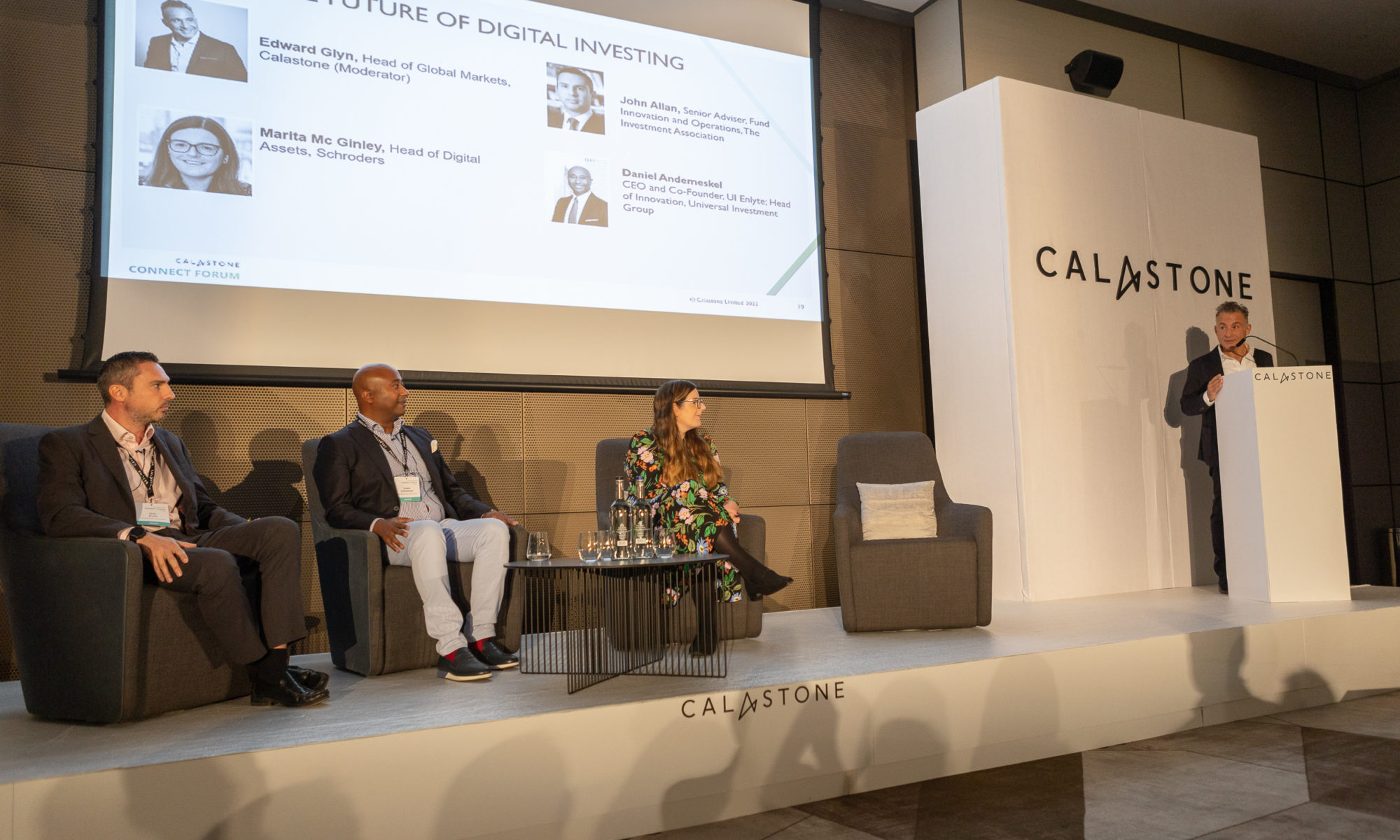After a three year break, we once again returned to London for our Calastone Connect Forum. Since we last met in person in 2019, the funds industry has undergone an unprecedented transformation, fuelled by rapid digitalisation and tectonic shifts in retail investor behaviour. In this time tokenisation has gained significant traction and at Calastone we have continued to work with clients to develop the operating model to make it a reality. For this Connect Forum, we looked at how close we are to tokenised collective investments, bringing together speakers from Calastone, Schroders, Universal Investments and the Investment Association.
In order to retain wallet share in this brave new world, asset managers need to start thinking seriously about tokenisation.
Waking up to the new reality
The gulf in user experiences when purchasing goods online through platforms – such as Amazon – versus acquiring units in a fund via a broker or IFA could not be starker.
“There are a number of different actors in the fund supply chain between the investor and the manager, including transfer agents, global custodians, fund accountants and fund administrators, each of whom is using their own different systems and technologies. This is not a recipe for success in a rapidly advancing digital age,” says Edward Glyn, our Head of Global Markets.
Since the pandemic, retail investor behaviour and expectations have dramatically changed. “The funds world is dealing with a new investor type, and one that is very different from the investors we knew a decade ago, or even back in 2019,” Edward added. During lockdown, many young people discovered investing for the first time, and built up exposures to stocks, alternative assets and digital investment products such as crypto-currencies and non-fungible tokens, often based on tips procured from social media and online message boards.
In addition to wanting greater access to a wider gamut of investment products and asset classes, modern allocators have come to expect to receive a highly bespoke, micro-personalised service at low cost. This new cohort of investors also craves a seamless digital user experience when buying funds, similar to that of a lifestyle app.
So how exactly is the funds industry going to win over this new legion of digitally native investors?
Tokenisation – funds 3.0
There are some extraordinary advances being made in the field of tokenisation, namely the representation of an asset or pool of assets as a digital token, which can then be transacted on a Blockchain or DLT (distributed ledger technology). Forward-thinkers in the funds industry are paying attention to this technology, and we are no exception.
Commenting on our operating model, Edward said, “Instead of tinkering with the existing structure of a fund by tokenising mutual fund units, we are looking to directly tokenise collectives of assets for distribution onto the mass market using our DMI (distributed market infrastructure). In essence, we are building a market-place. Here, investors, investment managers, and other participants can offer products and purchase the services required to support them.”
Tokenisation could unlock a number of strategic benefits for both asset managers and their clients. It will facilitate better automation in activities such as fund pricing and accounting, combined with greater visibility, instant settlement and enhanced analytics, all of which will help alpha generation by shaving basis points (bps) off managers’ costs.
The Investment Association (IA) considers that the potential for change offered by these and complimentary innovations could usher in a new era for fund management – so called ‘Investment Fund 3.0’.
Meanwhile, investors – through fractionalisation – will gain access to asset classes which were previously unavailable to them on cost grounds, while also benefiting from better transparency and the ability to make instant purchases. In addition, tokenisation will make it easier for retail investors to personalise their portfolios.
Experts are certainly bullish about the potential of tokenisation. “Over the last few years, we have seen the size of the token economy increase. Today, the tokenisation market is worth around $2 trillion, but this could increase to $7 trillion by 2025. We are now seeing more of the incumbent providers investing into the token economy,” according to Daniel Andemeskel, CEO and Co-Founder of UI Enlyte and Head of Innovation at Universal Investment Group.
What needs to happen next….
While tokenisation offers huge potential, its success will be contingent on several things happening first. Agreement on the meaning of the new terminology and concepts being introduced is important to establish quickly, as well as a clear industry view on the benefits to investors of the technology, including how to achieve them in the short and medium terms were points raised by John Allan, Senior Adviser, Fund Innovation and Operations at The Investment Association (IA).
Similarly, the establishment of comprehensive standards governing tokenisation and the technologies underpinning it will be equally crucial. A failure to do this could create risks such as technology fragmentation, inhibiting interoperability between different systems.
If tokenisation is to thrive, regulations will also need to be accommodative, something which appears to be happening in a handful of markets – with Germany widely considered to be a leader in this space, says Allan. Having introduced rules allowing the country’s institutional funds – otherwise known as Spezialfunds – to invest up to 20% of their assets in crypto, [1] Germany’s regulators will now permit fund managers to issue fund units on an electronic instead of physical basis. [2]
“In the UK, the IA has been examining the potential for fund tokenisation for the last 18 months now, and it is engaging closely with the UK’s Financial Conduct Authority (FCA) on this very subject,” explains Allan.
In addition to supporting the IA’s move to push the FCA on enabling the roll-out of DLT-traded funds, we at Calastone are collaborating closely with several leading asset managers in building our tokenisation model, and this is something which is also being presented to regulators.
That regulators are paying closer attention to tokenisation is indicative of the technology’s growing maturity and clout. As regulators become more involved, that could encourage more investors to participate in the market, and buy into digital asset products.
Although there are different views on when tokenisation will enter into the mainstream, we believe that the first stages of a tokenisation model could become reality within a year. “We have the capability, expertise and global network to help the investment ecosystem, apply it practically and reap the benefits from day one”, Edward said as he was closing the forum.
Tokens take centre stage
Tokenisation offers extensive advantages to fund managers, investors and the wider industry. The automation it provides will help firms obtain cost synergies, precipitating in a much needed boost to overall returns. At the same time, tokenisation gives investors more choice and digitalises the entire fund buying process, a prerequisite if the funds industry is to broaden its reach to younger audiences.
[1] Coin Telegraph – July 31, 2021 – German law allowing institutional funds to hold crypto comes into effect August 2
[2] Goodwin Law – Germany introduces new rules on crypto-funds











